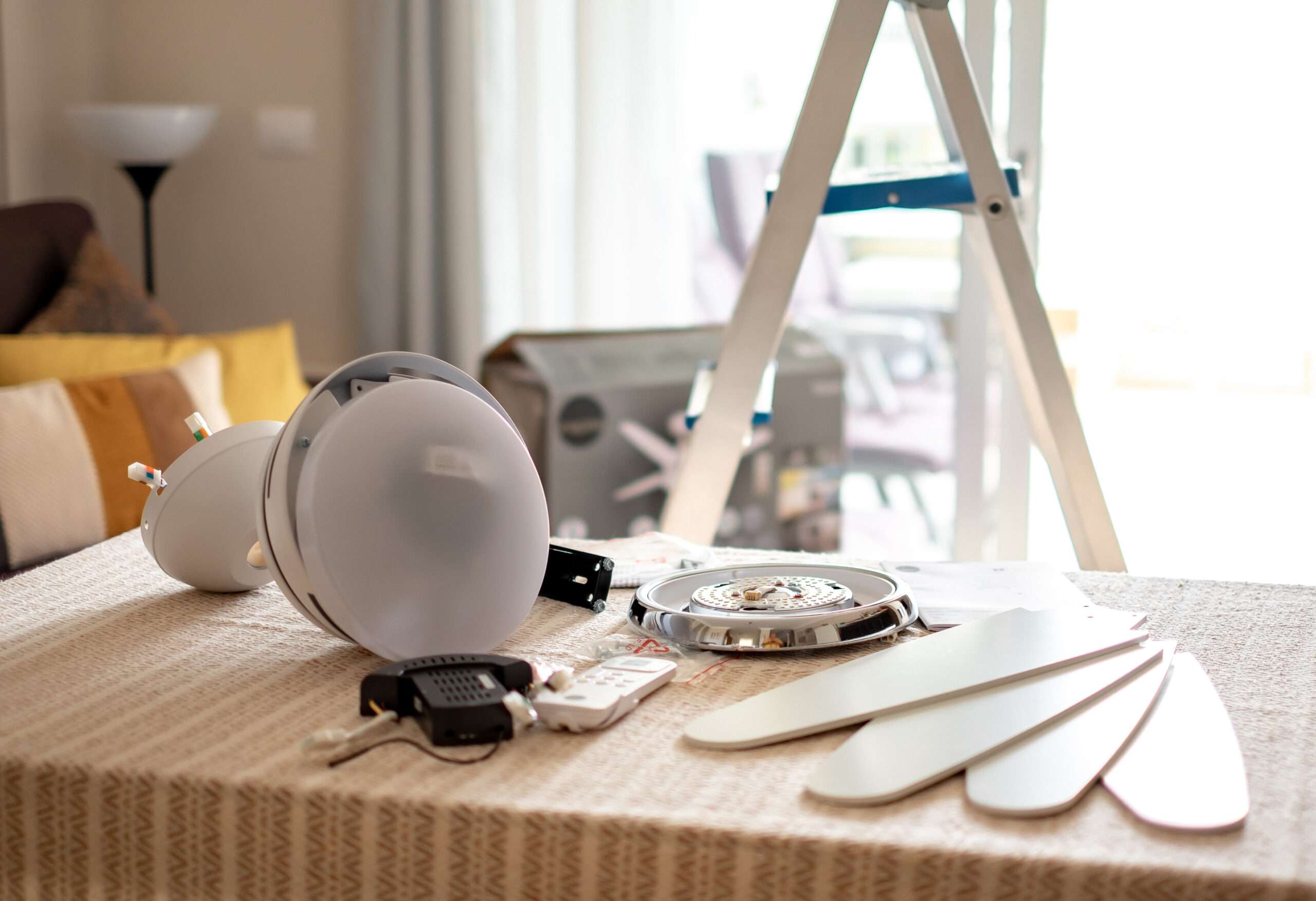Are you wondering why ceiling fans are essential for your home?
Ceiling fans are not just a staple in home decor; they offer numerous practical benefits that enhance your living environment. These versatile devices provide a perfect balance of comfort, style, and energy efficiency, making them a must-have for any household.
One of the primary reasons to install fans in your home is the improved comfort they provide. These fans circulate air, creating a breeze that can make a room feel significantly cooler during the hot summer months.
Ceiling fans are a cost-effective way to reduce your energy bills. By using fans in conjunction with your air conditioning or heating system, you can set your thermostat a few degrees higher in the summer or lower in the winter without sacrificing comfort. This adjustment can lead to substantial savings on your energy bills. Fans can reduce cooling costs by up to 40% and heating costs by up to 10%.
In this guide, you’ll learn all there is to know about ceiling fans.

Benefits of Ceiling Fans
Ceiling fans offer a multitude of benefits that make them an excellent addition to any home. From improving air circulation to providing cost-effective cooling and heating solutions, here are the key advantages of installing fans in your living spaces.
Energy Efficiency and Cost Savings
Ceiling fans are renowned for their energy efficiency. When used in conjunction with your HVAC system, ceiling fans can help to reduce your energy consumption significantly.
By creating a cooling breeze, ceiling fans allow you to set your thermostat higher in the summer without sacrificing comfort.
In the winter, reversing the fan’s direction helps distribute warm air more evenly, allowing you to set your thermostat lower. These adjustments can lead to energy savings of up to 40% on cooling costs and 10% on heating costs.
Enhanced Air Circulation
One of the primary benefits of ceiling fans is their ability to enhance air circulation within a room. This increased airflow helps to maintain a consistent temperature throughout the space, eliminating hot or cold spots.
Improved air circulation also promotes better indoor air quality by reducing humidity levels and minimizing the potential for mold and mildew growth.
Versatility in Design and Functionality
Ceiling fans come in a wide variety of styles, sizes, and finishes, making them a versatile choice for any home decor. Whether you prefer a modern, sleek design or a
more traditional, ornate look, there is a ceiling fan to match your aesthetic preferences.
Additionally, many ceiling fans come with integrated lighting options, combining illumination and air circulation in one convenient fixture. This dual functionality can save space and reduce the need for additional light sources in your home.
Year-Round Comfort
Ceiling fans are not just for summer cooling. They provide year-round comfort by aiding in both cooling and heating your home. In the summer, ceiling fans should rotate counterclockwise to create a cooling breeze.
In the winter, reversing the fan to rotate clockwise helps to distribute warm air that rises to the ceiling back down into the room. This seasonal versatility makes ceiling fans a practical and cost-effective solution for maintaining a comfortable home environment throughout the year.
Environmentally Friendly
Using ceiling fans is an environmentally friendly way to enhance your home’s comfort. By reducing the reliance on your HVAC system, ceiling fans help to lower your overall energy consumption. This reduction in energy usage not only saves money but also reduces your carbon footprint, contributing to a more sustainable lifestyle.
Improved Sleep Quality
Ceiling fans can also improve your sleep quality by creating a gentle breeze and white noise that many people find soothing. The consistent airflow helps to regulate the room temperature, ensuring a more comfortable sleeping environment. This can be particularly beneficial during hot summer nights when staying cool can be challenging.
Added Home Value
Installing ceiling fans can add value to your home. Potential buyers often view ceiling fans as a desirable feature due to their energy efficiency, cost savings, and aesthetic appeal. This added value can make your home more attractive to buyers and potentially increase its marketability.
Ceiling fans offer numerous benefits, from enhancing comfort and air circulation to providing energy-efficient and environmentally friendly solutions. Their versatility in design and year-round functionality make them a smart addition to any home.
Understanding Different Types of Ceiling Fans
Selecting the right ceiling fan involves understanding the different types available and their specific applications. This section explores the various types of ceiling fans, helping you make an informed decision for your home.
Indoor vs. Outdoor Ceiling Fans
Indoor Ceiling Fans
Indoor ceiling fans are designed for use inside the home. They come in a variety of styles and sizes to match any interior decor, from living rooms and bedrooms to kitchens and bathrooms. These fans are built to provide optimal air circulation in climate-controlled environments.
Outdoor Ceiling Fans
Outdoor ceiling fans are specially constructed to withstand the elements. They are typically made of durable materials such as stainless steel and weather-resistant finishes.
Outdoor fans are ideal for patios, porches, and other outdoor living spaces. They are often rated for damp locations, ensuring they can handle exposure to moisture and humidity without damage.
Low Profile vs. Standard Profile Fans
Low Profile Ceiling Fans
Low-profile ceiling fans, also known as huggers or flush mount fans, are designed for rooms with low ceilings, typically under 8 feet. These fans are mounted directly to the ceiling without a download, maximizing headroom and providing adequate air circulation in small spaces. They are perfect for basements, attics, and other areas with limited vertical space.
Standard Profile Ceiling Fans
Standard profile ceiling fans are suitable for rooms with ceilings 8 feet or higher. These fans are installed with a downrod, allowing them to hang at an optimal height for air circulation. The downrod length can be adjusted to suit different ceiling heights, ensuring efficient airflow in any room. Standard profile fans are versatile and available in various styles to complement any decor.
Ceiling Fan Sizes: Finding the Right Fit
Choosing the right ceiling fan size is crucial for maximizing efficiency and comfort. Here’s how to determine the best size for your room:
Measuring Your Room
To find the right fan size, measure the room’s square footage by multiplying the length by the width. This measurement helps you match the fan size to the room size, ensuring adequate air circulation.
Recommended Fan Sizes by Room Dimensions
- Small Rooms (up to 75 sq. ft.): For small spaces like bathrooms or hallways, a fan with a blade span of 29-36 inches is ideal.
- Medium Rooms (76-144 sq. ft.): Bedrooms, kitchens, and other medium-sized rooms benefit from fans with a blade span of 36-42 inches.
- Large Rooms (145-225 sq. ft.): Living rooms and larger bedrooms require fans with a blade span of 44-50 inches.
- Great Rooms (over 225 sq. ft.): For expansive spaces, choose a fan with a blade span of 50-72 inches to ensure optimal air circulation.
Blade Materials and Styles
Ceiling fan blades come in various materials and styles, each offering unique benefits and aesthetic appeal.
Wood Blades
Wood blades add a touch of elegance and warmth to any room. They are available in numerous finishes, from natural wood to painted or stained options. Wood blades are ideal for indoor use and can complement traditional, rustic, or modern decor.
Metal Blades
Metal blades are durable and easy to clean, making them suitable for both indoor and outdoor use. They often feature sleek, contemporary designs and are perfect for industrial or modern spaces. Metal blades are also resistant to warping and moisture damage.
Plastic Blades
Plastic blades are lightweight and versatile. They can mimic the appearance of wood or metal while offering increased resistance to moisture and humidity. Plastic blades are an excellent choice for outdoor fans or areas with high humidity, such as bathrooms or kitchens.
Aesthetic and Functional Considerations
When choosing ceiling fan blades, consider both aesthetic and functional factors. The blade material and style should complement your room’s decor while providing the desired level of airflow and durability.
Whether you prefer the natural beauty of wood, the sleek look of metal, or the versatility of plastic, selecting the right blade can enhance both the function and appearance of your ceiling fan.
Understanding the different types of ceiling fans, including their applications, sizes, and materials, ensures you choose the perfect fan for your home. With the right fan, you can enjoy enhanced comfort, style, and energy efficiency.
Ceiling Fan Features to Consider
When selecting a ceiling fan, several features can enhance its functionality, convenience, and overall performance. From remote controls to integrated lighting, understanding these features will help you choose the best ceiling fan for your home.
Remote Controls and Smart Features
Remote Controls
One of the most convenient features of modern ceiling fans is the remote control capability. Remote controls allow you to adjust the fan speed, direction, and lighting (if applicable) from anywhere in the room.
This feature eliminates the need to use pull chains or wall switches, providing ease of use and added comfort. Remote controls are especially useful in bedrooms and living rooms, where you might want to change settings without getting up.
Smart Features
Smart ceiling fans take convenience a step further by integrating with home automation systems. These fans can be controlled via smartphone apps, voice commands, or through platforms like Amazon Alexa, Google Home, and Apple HomeKit. Smart features often include:
- Scheduling: Set the fan to turn on or off at specific times.
- Geofencing: The fan can automatically adjust based on your location, turning off when you leave and on when you return.
- Energy Monitoring: Track energy usage and efficiency.
- Scene Setting: Integrate the fan with other smart devices to create customized scenes, such as a “Good Night” mode that dims lights and reduces fan speed.
Integrated Lighting Options
Many ceiling fans come with integrated lighting, combining both air circulation and illumination in a single fixture. This dual functionality is ideal for rooms with limited ceiling space or where a streamlined look is desired. Here are some considerations:
- Types of Lighting: Ceiling fans can come with various types of lighting, including LED, halogen, and incandescent bulbs. LED lights are the most energy-efficient and long-lasting.
- Dimmable Options: Some ceiling fans feature dimmable lights, allowing you to adjust the brightness to suit different moods and activities.
- Design Variety: Lighting kits are available in numerous styles and finishes, from modern to traditional, ensuring that the fan complements your home decor.

Installation Tips for Ceiling Fans
Installing a ceiling fan can be a straightforward DIY project, but it’s essential to follow proper guidelines to ensure safety and optimal performance.
DIY vs. Professional Installation
DIY Installation
If you’re comfortable with basic electrical work and have the necessary tools, you can install a ceiling fan yourself. Make sure to follow the manufacturer’s instructions carefully.
Professional Installation
For complex installations, such as those involving high ceilings, multiple fans, or new electrical wiring, hiring a professional electrician is recommended. Professional installation ensures that the fan is securely mounted and properly wired, reducing the risk of accidents or malfunctions.
Tools and Safety Precautions
When installing a ceiling fan, you’ll need the following tools:
- Screwdrivers (both flat-head and Phillips)
- Pliers
- Wire strippers
- Ladder
- Voltage tester
- Drill and bits
Safety precautions to keep in mind:
- Turn off the power to the circuit before starting any electrical work.
- Use a sturdy ladder and ensure it is placed on a stable surface.
- Check that the ceiling box is fan-rated to support the weight and motion of the fan.
- Follow all installation instructions provided by the manufacturer.
Considering these features and installation tips will help you choose and set up a ceiling fan that meets your needs for comfort, convenience, and energy efficiency.
Ceiling Fan Maintenance and Troubleshooting
Proper maintenance and troubleshooting of your ceiling fan can extend its lifespan and ensure it operates efficiently. This section covers regular cleaning and care, as well as common issues and solutions to keep your ceiling fan running smoothly.
Regular Cleaning and Care
Dusting and Cleaning
Regular dusting and cleaning are essential to maintain the performance and appearance of your ceiling fan. Dust and dirt can accumulate on the blades, motor housing, and other parts, affecting airflow and potentially causing noise.
Lubrication
Some ceiling fans require periodic lubrication to keep the motor running smoothly. Check your fan’s manual to see if this is necessary. If so, apply a few drops of oil to the motor bearings as directed.
Check for Loose Screws and Connections
Over time, screws and connections can become loose due to the fan’s movement. Periodically check all screws, including those on the blades, light fixtures, and mounting bracket, and tighten them as needed.
Common Issues and Solutions
Even with regular maintenance, ceiling fans can encounter issues. Here are some common problems and their solutions:
Fan Wobbling
A wobbling fan can be caused by several factors, including unbalanced blades, loose screws, or an improperly mounted fan.
Noisy Operation
Noise can be due to several factors, such as loose parts, unbalanced blades, or motor issues.
Fan Not Turning On
If your ceiling fan doesn’t turn on, there could be several reasons:
- Ensure the fan is connected to a functioning power source and that the circuit breaker hasn’t tripped.
- If your fan uses a remote control, check the batteries and ensure it is functioning correctly.
- Inspect the wiring connections to ensure they are secure. If you’re uncomfortable with electrical work, consider hiring a professional electrician to check the wiring.
Lights Not Working
If the fan’s lights aren’t working:
- Ensure the bulbs are not burned out and are screwed in properly.
- Check the wiring connections in the light kit. Loose or disconnected wires could be the issue.
- Check If the light kit is faulty, you may need to replace it with a new one.
FAQs
-
How do I choose the right ceiling fan size?
Choosing the right ceiling fan size depends on the dimensions of the room. Measure the room’s length and width to determine its square footage.
-
What are the benefits of DC motor fans?
DC motor ceiling fans are highly energy-efficient, using up to 70% less electricity than AC motors.
-
Can ceiling fans help reduce energy costs?
Yes, ceiling fans can significantly reduce energy costs. By creating a breeze in the summer, ceiling fans allow you to set your thermostat higher, reducing the load on your air conditioning system.
-
How often should I clean my ceiling fan?
It’s recommended to clean your ceiling fan at least once a month to maintain its performance and appearance.
-
Is professional installation necessary for ceiling fans?
Professional installation is not always necessary, especially if you are comfortable with basic electrical work and have the necessary tools. However, for complex installations involving high ceilings, multiple fans, or new electrical wiring, hiring a professional electrician is recommended.






























